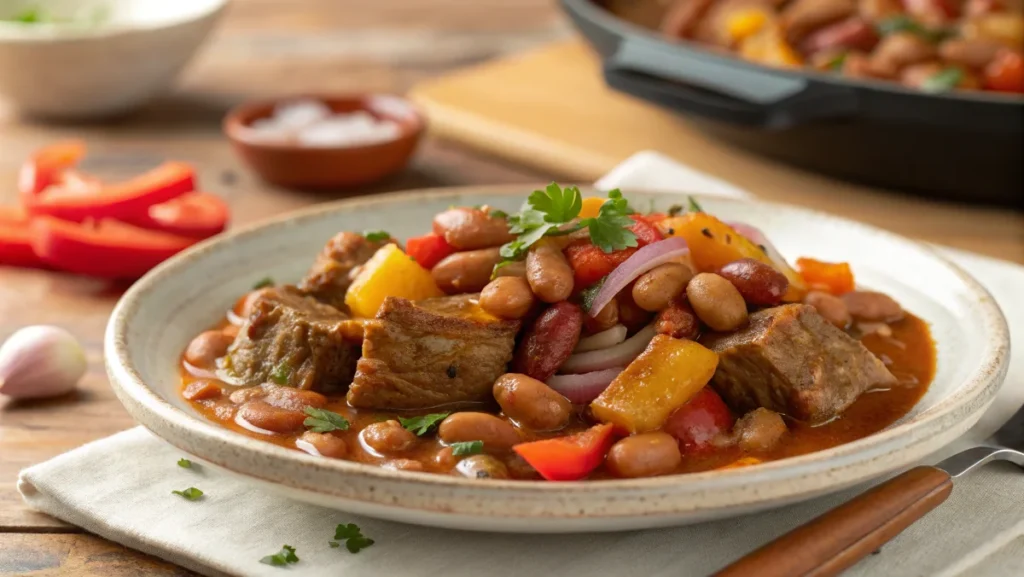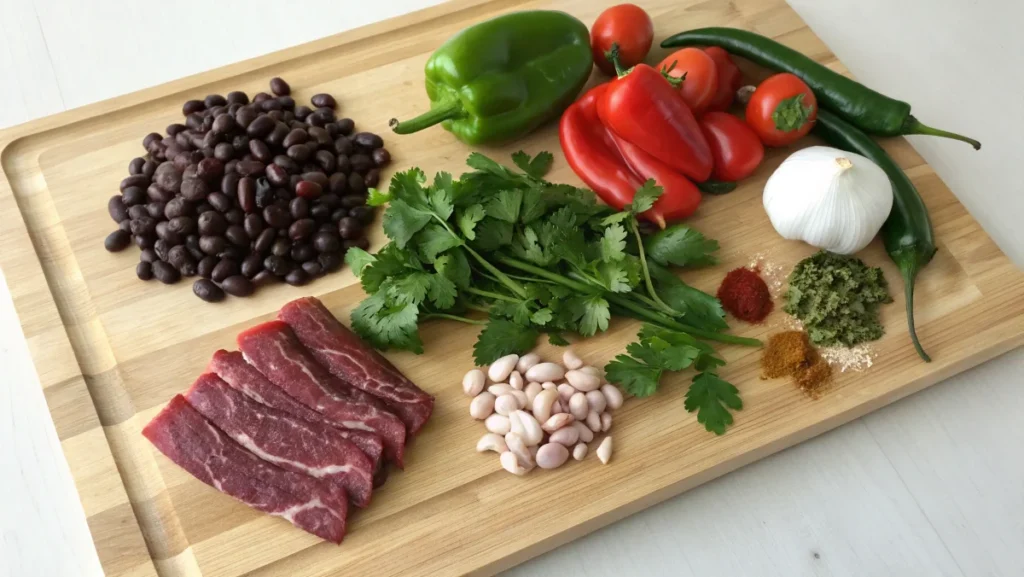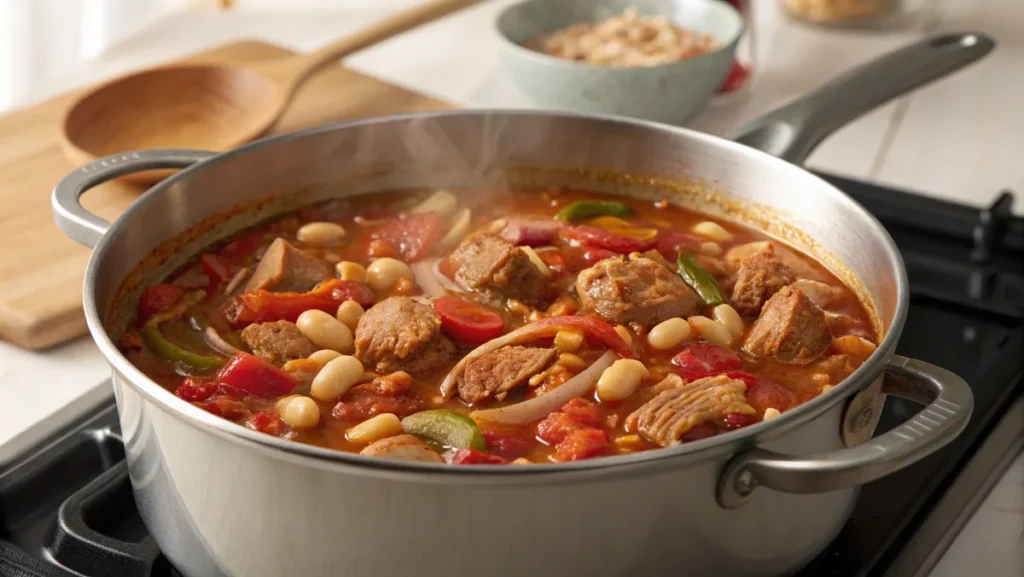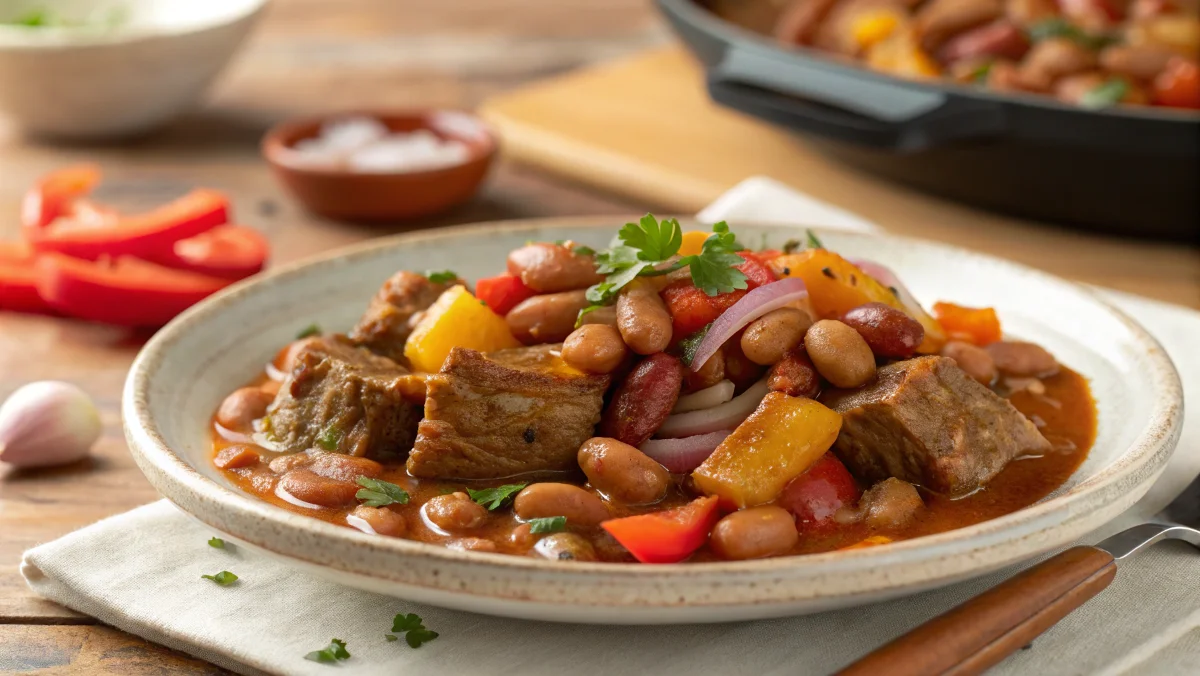Habichuelas, or beans, are a cornerstone of Latin American cuisine, offering both a nutritious food source and a deep cultural connection. Historically, beans are among the oldest cultivated crops, feeding indigenous populations for centuries. Their adaptability in recipes has made them a staple in countries from Mexico to Argentina.
Beyond their culinary versatility, habichuelas are a powerhouse of nutrition, rich in protein, fiber, and essential vitamins, making them a vital component of a balanced diet. They pair easily with a variety of foods, enhancing their prominence in daily meals. Additionally, the cultural and traditional values tied to beans underscore their significance, transcending their role as mere ingredients.
If you’re looking to explore a comforting dish that highlights how versatile such staples can be, try the Sweet and Sour Meatballs Recipe. This recipe balances tangy and sweet flavors, creating a satisfying meal that’s sure to please.
By celebrating habichuelas and other culinary staples, we honor the rich traditions and sustenance they continue to provide.

The History and Cultural Significance of Beans
The history of beans dates back thousands of years to the indigenous peoples of Latin America. Specifically, the Mayans and Aztecs were among the first to cultivate beans. They valued the beans for their nutritional benefits and incorporated them into their daily meals. As a result, beans quickly became an essential part of their culture and diet.
As European colonizers introduced new crops and cooking methods, beans maintained their significance, becoming part of religious rituals, celebrations, and traditions. Habichuelas came to symbolize unity and prosperity across Latin American societies.
Today, habichuelas remain a cherished symbol of heritage, reflecting the resilience of traditional cooking practices. Whether served simply with rice or in hearty stews, beans tell the story of Latin America’s rich history and culture.
For an easy-to-prepare dish that’s perfect for any occasion, check out this recipe: Can I Make Sweet and Sour Meatballs Ahead of Time? Easy Make-Ahead Recipe. This delightful guide shows how to save time while creating a flavorful meal.
Different Types of Habichuelas: Varieties of Beans
There is an incredible diversity of habichuelas, each offering distinct flavors and textures. In fact, these varieties can differ based on their color, size, and origin. Additionally, some of the most common types include:
- Black Beans (Habichuelas Negras): Black beans, a staple in many Latin American dishes, have a rich, earthy flavor. People commonly use them in Cuban and Puerto Rican recipes.
- Red Beans (Habichuelas Rojas): Popular in Dominican and Puerto Rican cooking, red beans are slightly sweeter and have a soft texture when cooked.
- Kidney Beans (Habichuelas Coloradas): These beans are larger and have a slightly firmer texture. They are often used in stews and soups.
- Pinto Beans (Habichuelas Pintas): Known for their distinctive mottled appearance, pinto beans are popular in Mexican cuisine, often used in refried beans.
- White Beans (Habichuelas Blancas): People often use these beans in lighter dishes, and they make a great alternative for those seeking a milder flavor.
Each type of habichuela brings its unique characteristics to dishes, allowing for a wide variety of flavors and textures. Depending on the dish, the choice of bean can completely change the final outcome, making habichuelas versatile and customizable.

How Habichuelas Are Used in Traditional Recipes
In Latin American cuisine, beans are used in a myriad of ways. They serve as the base for countless traditional recipes, from simple side dishes to hearty stews and soups. The method of cooking them can vary greatly from country to country, but they all showcase the richness and depth of Latin American culinary traditions.
For example, in Puerto Rico, people often prepare habichuelas in a savory tomato-based sauce with spices such as garlic, onion, and bell peppers. In Mexico, cooks frequently incorporate beans into refried beans, which serve as a staple side dish at almost every meal.
Some other traditional ways to use habichuelas include:
- Sopa de Habichuelas (Bean Soup): A comforting dish made with beans, vegetables, and meats like chicken or beef.
- Habichuelas Guisadas: A Puerto Rican stewed bean dish typically cooked with onions, garlic, bell peppers, and ham or bacon.
- Frijoles Negros: A Cuban dish made with black beans cooked in a flavorful broth and served alongside rice.
The versatility of habichuelas in Latin American cooking highlights their importance in creating both simple and complex dishes. The variety of cooking methods ensures that they remain a beloved ingredient for families across generations.
The Nutritional Benefits of Including Habichuelas in Your Diet
Habichuelas are a great source of nutrition, making them an important part of a healthy diet. These beans offer key nutrients that help with overall health. Here are some of the main benefits of adding habichuelas to your meals:
- High Protein Content: Beans are an excellent source of plant-based protein, which is crucial for building and repairing tissues. This makes habichuelas an excellent option for vegetarians and vegans.
- Rich in Fiber: Habichuelas are high in dietary fiber, which promotes digestive health and helps regulate blood sugar levels.
- Vitamins and Minerals: These beans are rich in essential vitamins such as folate, which is important for cell growth and metabolism, and minerals like iron, which is vital for the production of red blood cells.
- Low in Fat: Most varieties of habichuelas are naturally low in fat, making them an ideal food for those looking to maintain or lose weight.
Including habichuelas in your diet offers numerous health benefits. For instance, they support heart health and help with weight management. Additionally, their high fiber and protein content make them a key food for anyone looking to improve their nutrition. Moreover, by adding habichuelas to your meals, you can enjoy both great taste and better overall health. To complement your meal with a hearty and comforting dish, consider trying the Sweet and Sour Meatballs: A Flavorful Comfort Food Recipe. This recipe combines bold flavors and satisfying textures for a delightful addition to your dining table.
Popular Bean Dishes Across Latin America
Throughout Latin America, people include beans in many beloved dishes that vary from region to region. These dishes often reflect unique cultural influences and local ingredients. For example, some of the most popular dishes featuring beans include:
- Arroz con Habichuelas (Rice with Beans): A quintessential Latin American dish, this combination of beans and rice often serves as a side dish or main course in countries like the Dominican Republic and Puerto Rico.
- Feijoada: Feijoada is a hearty Brazilian stew made with black beans, beef, and spices, traditionally served during festivals and holidays.
- Tacos de Frijoles: In Mexico, people often use beans as a filling for tacos, pairing them with meats, vegetables, and flavorful salsas.
- Habichuelas con Dulce: A sweet dessert from the Dominican Republic, this dish features beans cooked with coconut milk, cinnamon, and sugar.
The popularity of these dishes highlights the strong connection between beans and Latin American cooking traditions. Additionally, their many uses in different recipes show how versatile beans are in taking on various flavors and cooking styles. As a result, beans play a central role in the diverse culinary landscape of Latin America.
Cooking Techniques for Perfectly Prepared Habichuelas
Achieving the perfect habichuelas requires the right cooking techniques to enhance their flavor and texture. Whether you’re preparing beans from scratch or using canned varieties, there are a few tips that can help ensure the best results:
- Soaking Dried Beans: Soaking beans overnight helps to reduce cooking time and ensures that they cook more evenly. If you’re short on time, a quick soak method involves boiling the beans for a few minutes and then letting them sit for an hour.
- Using a Pressure Cooker: For faster cooking, a pressure cooker can be a real time-saver. It dramatically reduces cooking time, making it ideal for dried beans.
- Seasoning with Aromatics: Habichuelas absorb flavors well, so it’s important to season them with aromatics like garlic, onions, and bell peppers. Herbs like cilantro and thyme also add depth to the flavor profile.
- Simmering Slowly: Cooking habichuelas on low heat for an extended period helps to release their natural flavors and achieve a tender, creamy texture.
By using these techniques, you can create perfectly cooked habichuelas every time, ensuring that they are a delicious and nutritious addition to any meal.

Regional Variations in Bean Recipes
People enjoy habichuelas throughout Latin America, and each country adds its own unique twist on how they prepare and serve them. Furthermore, the regional variations in habichuelas recipes reflect the diversity of Latin American culture and cooking traditions. For example, some notable variations include:
- Dominican Republic: In the Dominican Republic, beans are often stewed with beef or chicken, creating a rich and flavorful dish. Habichuelas Guisadas is a classic example of this.
- Cuba: In Cuba, cooks typically prepare black beans with bay leaves, garlic, and onions, creating a simple yet flavorful dish often served with rice.
- Mexico: Pinto beans are a staple in Mexican cuisine, frequently used in refried beans or as the base for dishes like burritos or enchiladas.
- Brazil: In Brazil, people make feijoada, a traditional dish with black beans and a variety of meats like sausage, beef, and chicken.
These regional differences show how the use of habichuelas can change based on local ingredients, spices, and cultural influences. However, the main ingredient stays the same, making beans a key part of Latin American cooking.
Creative Ways to Incorporate Habichuelas Into Modern Meals
While beans are deeply rooted in traditional Latin American cooking, there are many creative ways to incorporate them into modern meals. These innovative approaches blend the timeless appeal of beans with contemporary cooking styles, making them a versatile ingredient for any kitchen. Here are some ideas:
- Bean Burgers: Use habichuelas as the base for a vegetarian burger patty. Simply mash the beans with spices, breadcrumbs, and vegetables, then pan-fry until crispy.
- Bean Bowls: Create a healthy, customizable bean bowl by combining habichuelas with grains, roasted vegetables, and a zesty sauce like avocado crema or cilantro-lime dressing.
- Bean Salads: Incorporate habichuelas into a refreshing salad by mixing them with fresh greens, tomatoes, onions, and a tangy vinaigrette.
- Stuffed Vegetables: Use beans as a stuffing for peppers, zucchini, or tomatoes. Combine the habichuelas with cheese, grains, and spices for a wholesome meal.
These modern takes on habichuelas show that beans can be incorporated into a wide range of contemporary dishes. Whether you’re looking to create a plant-based meal or simply elevate your regular menu, beans provide endless possibilities. For an exploration of diverse pasta dishes and classifications, check out What Are the 4 Basic Italian Pastas? Top Dishes & Classifications Explained, which provides insight into popular culinary options that pair well with beans or other modern creations.
How to Store and Preserve Dried and Cooked Habichuelas
Properly storing habichuelas ensures they stay fresh and maintain their nutritional value. Whether you’re working with dried or cooked beans, there are specific methods to extend their shelf life.
Dried Habichuelas
- Cool, Dry Storage: Store dried habichuelas in an airtight container in a cool, dry place. They can last for up to one year if kept in optimal conditions.
- Freezing Dried Beans: If you want to extend their shelf life even further, you can freeze dried habichuelas for up to two years. This method preserves their flavor and prevents pest infestation.
Cooked Habichuelas
- Refrigeration: After cooking, store habichuelas in an airtight container in the refrigerator. They can stay fresh for up to five days.
- Freezing Cooked Beans: For long-term storage, freeze cooked beans in portion-sized containers. They can last for up to six months in the freezer.
By following these storage methods, you can ensure that your habichuelas remain fresh and ready to use in your next meal.
FAQs
What are Habichuelas?
Habichuelas are the Spanish term for beans, a vital component of many Latin American cuisines. These beans come in various types, such as black beans, red beans, pinto beans, and kidney beans. Habichuelas are known for their rich nutritional profile, offering a good source of protein, fiber, vitamins, and minerals. Often considered a staple food, people use them in a wide range of dishes across Latin America, making them a central ingredient in many traditional and modern recipes.
How are Habichuelas prepared?
Preparing beans generally involves cooking dried beans or using canned beans for convenience. To cook dried beans, you typically need to soak them overnight to reduce cooking time. Once soaked, cooks simmer the beans with aromatics like garlic, onions, and bell peppers. They may also season them with spices like cumin, cilantro, and bay leaves. Depending on the type of beans, people can boil, stew, or use them in soups and stews. Some popular methods include making stewed beans or bean soup.
Is Habichuelas served with other dishes?
Yes, habichuelas are commonly served with other dishes. One of the most popular ways to enjoy beans in Latin American cuisine is by pairing them with rice. In fact, dishes like arroz con habichuelas (rice with beans) are a daily staple in many countries. People often serve beans alongside meats, such as chicken, beef, or lamb. They can also be incorporated into tacos, salads, or served as part of a larger spread. Their versatility allows them to complement a wide range of meals, both savory and sweet.
Can I make Habichuelas in advance?
Absolutely! Beans are a great dish to make in advance. Once prepared, you can store both cooked dried beans and stewed beans in an airtight container in the refrigerator for up to five days. If you want to preserve them longer, you can freeze cooked beans for up to six months. This makes them an excellent meal prep option. As a result, you can enjoy them as a quick side dish or main course throughout the week. Additionally, freezing them helps save time and ensures you always have a healthy meal on hand.
Conclusion
Habichuelas are a cornerstone of Latin American cuisine, offering both cultural significance and numerous health benefits. Whether prepared in traditional dishes or incorporated into modern meals, beans provide flavor, nutrition, and versatility. With their rich history, diverse varieties, and countless culinary applications, habichuelas continue to be an essential ingredient in kitchens across the world. For a unique recipe that showcases culinary creativity, check out How Do You Make Sweet and Sour Meatballs From Scratch? | Easy & Tasty. This guide provides a step-by-step approach to creating a flavorful and satisfying dish from scratch.

